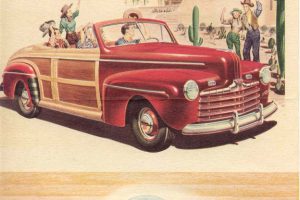After purchasing several NOS head gaskets, I wanted to determine the purpose of each. Looking through the “Green book” (Ford 2848 CHASSIS PARTS BOOK dated Nov. 1950) I noted that 91A-6051-A is for the 85hp, 24 stud, 1938-42 engines with large water openings and 41A-6051 is for the same engines. (Also the 41A replacement blocks for 1938-42) with small water opening.
A comparison of the two gaskets reveals that the 41A gasket has smaller coolant passages around the parameter especially in the area of the lower, front to center of the gasket. They are much smaller than the 91A gasket. The Green book also points out: the 41A gasket is to be used with the 81A and 81T heads of 1938-42 with new design and the new design head has 3/4-inch water hole at the center top edge between No. 4 and 5 valves and a 5/8-inch water hole at the center of the head between No. 2 and 3 cylinders.
The 91A gasket is to be used with the same heads with the old design. The old design head has 7/8-inch water hole at the center top edge between No. 4 and 5 valves and has 7/16-inch water hole at the center of the head between No. 2 and 3 cylinders. After checking with several engine technicians, 1 found they were aware of the new and old head designs and suggested the use of the new design by enlarging the holes with a drill but they could not lead me to Ford’s documentation as to the change. I felt that Ford would not leave this major of a change to a parts book. Since the 41A head gasket is not listed in the 1941 CHASSIS PARTS BOOK, then this design change had to occur between late 1941 and November, 1950 and the documentation would also be found between these dates.
I happened upon Ford’s REPAIR MANUAL OF V-8 ENGINES Form #3666-47G dated July 7, 1947. There pictured were the new and old design heads and gaskets and one sentence, “It is advisable when overhauling an engine to make modifications on the early type cylinder heads to obtain this extra cooling.” There it was although short and sweet not only Ford’s recommendation but the reason “extra cooling.”
With the water pumps located at the front of’ the engine, it appears too much of the volume of freshly pumped coolant was flowing through the lower front of the head and passing back to the radiator through the head when using the 91A gasket. This resulted in the coolant in the rear and upper center of the block and head not moving as fast. Ford decreased the size of the holes in the parameter of the 41A gasket especially those closest to the pumps. This forced the coolant from the pumps to better circulate to the rear and upper part of the block. Enlarging the two coolant holes in the head in the center and upper area of the head resulted in an increased volume of coolant at that location. In essence Ford used the head gasket to regulate the flow of coolant in the block and the head and their result was “extra cooling.” In order for this regulation to work the 41A gasket has to be installed properly. They have a small “V” notch cut into the front edge of this gasket, which must be installed toward the front of the block. This ensures the smallest of the coolant passages in the gasket are closest to the water pumps. Ford insists that if the “new design” head is not used then the 91A head gasket is to be used. If you are having overheating problems with a 1938-42 engine, I would explore all alternative as pointed out in several articles before removing the heads. If the heads have to come off or they have not yet gone on, check them out to see if they are of new or old design and make sure you are aware of the correct gasket to use. You may want to follow Ford’s advice for “extra cooling.”
Written by Terry Beich











